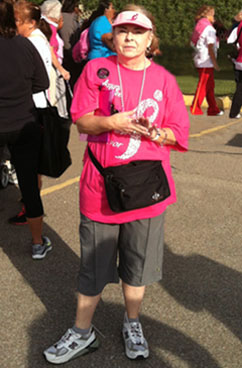
Photos and text used with permission of
Susan Crockett
When I was first diagnosed with breast cancer, it was 1984-I was 38 years old. My father had died of cancer 18 months earlier. I didn't know if I would live to see my three-year-old daughter graduate from high school. No one talked about breast cancer, and this was before the internet. I just didn't have much information about breast cancer, and no one in our family had been diagnosed before. The doctors told me that the tumor was small, and it had recently been announced that a lumpectomy with radiation therapy had the same survival rates as a mastectomy. I had a lumpectomy on the same day that my daughter started pre-school.
But I wasn't sick...the day after finishing radiation therapy, my husband drove me to our favorite place in Colorado for some early season snow skiing. We skied under beautiful blue Colorado skies. I began to feel as if my world would be OK-different, but OK. I had already decided that I needed to quit smoking and start running... I would outrun the cancer.
The days and miles started adding up. Wichita became the fourth city to host a Susan G. Komen Race For The Cure RACE®. My involvement with the RACE and with the Komen people provided me with support and information. For the first few years, two of my closest friends and I organized the RACE out of my dining room. Part of my Komen experience included lobbying Congress for funding for breast cancer research in 1992. One of my Komen friends created the phrase for the Survivor Buttons "Days into Years". Sadly, she did not get many more days.
As my days turned into years, my daughter did graduate from high school, and I went to graduate school. The summer after graduation, as I was working my 'first' job, the Mid-Kansas Affiliate of Susan G. Komen for the Cure nominated me to serve as a consumer peer reviewer for the Department of Defense (DOD) Breast Cancer Research Program (BCRP). Even though I start reviewing the material for each panel feeling totally overwhelmed, I do firmly believe that as a survivor, I offer a unique perspective to the process. The first panel I participated on reviewed research proposals in the area of radiation oncology. During lunch, we were visiting with the radiologists from the panel, who were discussing how they were beginning to see new breast cancer tumors in women who previously had radiation therapy following a lumpectomy. The proverbial light bulb went on: the first thing I did after coming home from my first peer review meeting was schedule a mammogram-it had been 18 years since my radiation therapy and lumpectomy.
The mammogram showed a small spot close to the chest wall in the same breast as my first diagnosis. My surgeon performed a stereotactical biopsy which removed a 0.6 cm malignant tumor. I had already received a lifetime's dosage of radiation, so I was given the option of a mastectomy. I opted for a bi-lateral mastectomy since there was no reason to leave the other breast to develop anything. My second diagnosis was more stressful than the first one- I knew so much more.
It has now been 3,650 days since that diagnosis. I've been blessed to have my days turn into years. I've met some wonderful people along the way; I've also lost some. I've been able to participate in more DOD BCRP panels to review proposals in many areas of breast cancer research. I always finish my peer reviews with hope from seeing the commitment of some of the best and brightest in breast cancer research.
We have so much more information about breast cancer available to patients and professionals than when I was first diagnosed, but it is a battle that we haven't yet won. We are still losing people to the disease every day, every year. It has not been eradicated as a life-threatening disease. Even though I continue to be inspired with hope by serving on peer review panels, I hope that I will have enough "days into years" to see this life-threatening disease become history.
Last updated Thursday, May 26, 2022














